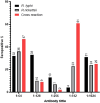SFG and TG seropositivity in Humans suspected of TBD in Yucatan, Mexico
- PMID: 39773301
- PMCID: PMC11795441
- DOI: 10.1017/S0950268824001894
SFG and TG seropositivity in Humans suspected of TBD in Yucatan, Mexico
Abstract
Since 1996, the incidence of rickettsiosis has been increasing in Yucatán, Mexico, but recent prevalence data are lacking. This study aimed to determine exposure to the Spotted Fever Group (SFG) and Typhus Group (TG) in human serum samples suspected of tick-borne diseases (TBD) between 2015 and 2022. A total of 620 samples were analysed using indirect immunofluorescence assay (IFA) to detect IgG antibodies against SFG (Rickettsia rickettsii) and TG (Rickettsia typhi), considering a titer of ≥64 as positive. Results showed that 103 samples (17%) were positive for R. rickettsii and 145 (24%) for R. typhi, while 256 (41%) and 229 (37%) were negative, respectively. There was a cross-reaction in 244 samples (39%). Individuals with contact with vectors, such as ticks, showed significant exposure to fleas (p = 0.0010). The study suggests a high prevalence of rickettsiosis and recommends prospective studies to assess the disease burden and strengthen surveillance and prevention in Yucatán, considering factors like temperature and ecological changes.
Keywords: Rickettsiosis; Yucatan; flea; tick-borne diseases; typhus; vectors.
Figures



Similar articles
-
Serologic study of the prevalence of rickettsiosis in Yucatán: evidence for a prevalent spotted fever group rickettsiosis.Am J Trop Med Hyg. 1999 Sep;61(3):405-8. doi: 10.4269/ajtmh.1999.61.405. Am J Trop Med Hyg. 1999. PMID: 10497980
-
Unrecognized spotted fever group rickettsiosis masquerading as dengue fever in Mexico.Am J Trop Med Hyg. 1996 Aug;55(2):157-9. doi: 10.4269/ajtmh.1996.55.157. Am J Trop Med Hyg. 1996. PMID: 8780453
-
Assessing human exposure to spotted fever and typhus group rickettsiae in Ontario, Canada (2013-2018): a retrospective, cross-sectional study.BMC Infect Dis. 2020 Jul 18;20(1):523. doi: 10.1186/s12879-020-05244-8. BMC Infect Dis. 2020. PMID: 32682398 Free PMC article.
-
Antibody Titers Reactive With Rickettsia rickettsii in Blood Donors and Implications for Surveillance of Spotted Fever Rickettsiosis in the United States.J Infect Dis. 2020 Mar 28;221(8):1371-1378. doi: 10.1093/infdis/jiz316. J Infect Dis. 2020. PMID: 31267128
-
[Clinical and epidemiological study of spotted fever group rickettsiosis in Albacete, Spain].Enferm Infecc Microbiol Clin. 2005 Apr;23(4):194-6. doi: 10.1157/13073143. Enferm Infecc Microbiol Clin. 2005. PMID: 15826542 Review. Spanish.
References
MeSH terms
Substances
LinkOut - more resources
Full Text Sources
Medical
Miscellaneous

